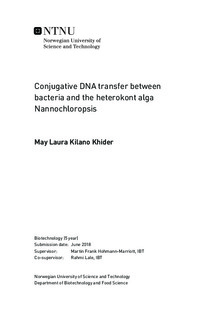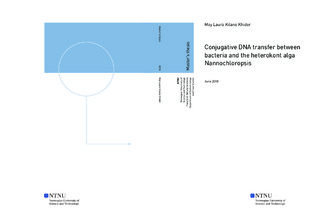| dc.description.abstract | The heterokont microalgae Nannochloropsis have been the subject of many
studies that focus on genomic and metabolic engineering. Research on this
genus has been motivated by the algae s high-level production of lipids and in
particular polyunsaturated fatty acids. The work presented in this thesis is part
of the effort to develop new tools that enable the rapid and reliable generation
of Nannochloropsis oceanica mutants.
A new growth medium was developed and evaluated against established Nan-
nochloropsis growth media. Compared with previously described growth media,
the new medium can be prepared without filtered sea water and improved growth
of N. oceanica.
Transkingdom conjugation has recently been established as a method for transfer
of DNA from Escherichia coli to two species of heterokont algae (Phaeodactylum
tricornutum and Thalassiosira pseudonana). For this phylum of algae, conju-
gation has the potential to replace the standard methods of transformation by
particle bombardment and electroporation. This project focuses on the develop-
ment of transkingdom conjugation as a method of establishing mutants of N.
oceanica (CCMP1779). Two E. coli strains were used as donors in the project,
S17-1 which has chromosomally integrated transfer functions, and DH10B har-
bouring the mobilization plasmid, pTA-Mob. Of these two donor strain, plasmid
transfer mediated by DH10B/pTA-Mob resulted in the highest conjugation
efficiency.
Preliminary work identified, that co-incubation of the recipient and donor cells at
30 ◦ C was crucial for establishing conjugation. Various conditions and parameters
were investigated for their effect on conjugation efficiency. The parameter of
recipient to donor ratio cells was found to be an important factor, but with
inconclusive results, further research is needed. During co-incubation of recipient
and donor cells, dark conditions resulted in higher conjugation efficiencies than
when cells were exposed to light. Temporal variations of the co-incubation
identified a maximum for conjugation efficiency at around 90 minutes.
A set of novel plasmids, pAPA0602 and pAPA0169, containing endogenous
promoters with reported high expression levels in N. oceanica and the standard
plasmid pSELECT100 were used in the conjugal transfer. ALl three of these
base vectors were gentically altered to include the origin of transfer, oriT. Two
additional constructs were created from the pAPA-plasmids, which included the
yeast sequence, CEN6-ARSH4-HIS3, that has been reported to enable episomal plasmid replication in diatoms. Of these five constructs, the highest conjugation
efficiency was observed with pAPA0169.
Transformation of N. oceanica by electroporation was conducted to compare
transformation efficiencies with conjugation efficiencies. The highest transfor-
mation efficiency obtained by electroporation was with the plasmid pAPA0602.
Electroporation was also used as the method to transform N. oceanica with
pAPA0602 and pAPA0169, to evaluate the tolerance against zeocin conferred
by a zeocin resistance gene under control of the pAPA plasmid-promoters. The
plasmids, pAPA0602 and pAPA0169 conferred tolerance to the antibiotic at
similar levels. Overall efficiencies obtained for pAPA0169 and pAPA0602 in this
project were higher than previously reported numbers.
The optimized conjugation protocol, together with the developed plasmids and
improved growth medium for mutant generation, extends the molecular toolbox
for N. oceanica. | |

